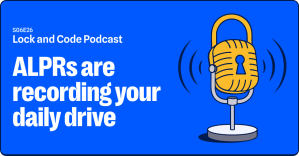This week on the Lock and Code podcast…
For decades, fake IDs had roughly three purposes: Buying booze before legally allowed, getting into age-restricted clubs, and, we can only assume, completing nation-state spycraft for embedded informants and double agents.
In 2024, that’s changed, as the uses for fake IDs have become enmeshed with the internet.
Want to sign up for a cryptocurrency exchange where you’ll use traditional funds to purchase and exchange digital currency? You’ll likely need to submit a photo of your real ID so that the cryptocurrency platform can ensure you’re a real user. What about if you want to watch porn online in the US state of Louisiana? It’s a niche example, but because of a law passed in 2022, you will likely need to submit, again, a photo of your state driver’s license to a separate ID verification mobile app that then connects with porn sites to authorize your request.
The discrepancies in these end-uses are stark; cryptocurrency and porn don’t have too much in common with Red Bull vodkas and, to pick just one example, a Guatemalan coup. But there’s something else happening here that reveals the subtle differences between yesteryear’s fake IDs and today’s, which is that modern ID verification doesn’t need a physical ID card or passport to work—it can sometimes function only with an image.
Last month, the technology reporting outfit 404 Media investigated an online service called OnlyFake that claimed to use artificial intelligence to pump out images of fake IDs. By filling out some bogus personal information, like a made-up birthdate, height, and weight, OnlyFake would provide convincing images of real forms of ID, be they driver’s licenses in California or passports from the US, the UK, Mexico, Canada, Japan, and more. Those images, in turn, could then be used to fraudulently pass identification checks on certain websites.
When 404 Media co-founder and reporter Joseph Cox learned about OnlyFake, he tested whether an image of a fake passport he generated could be used to authenticate his identity with an online cryptocurrency exchange.
In short, it did.
By creating a fraudulent British passport through OnlyFake, Joseph Cox—or as his fake ID said, “David Creeks”—managed to verify his false identity when creating an account with the cryptocurrency market OKX.
Today, on the Lock and Code podcast with host David Ruiz, we speak with Cox about the believability of his fake IDs, the AI claims and limitations of OnlyFake, what’s in store for the future of the site— which went dark after Cox’s report—and what other types of fraud are now dangerously within reach for countless threat actors.
Making fake IDs, even photos of fake IDs, is a very particular skill set—it’s like a trade in the criminal underground. You don’t need that anymore.
Joseph Cox, 404 Media co-founder
Tune in today to listen to the full conversation.
Show notes and credits:
Intro Music: “Spellbound” by Kevin MacLeod (incompetech.com)
Licensed under Creative Commons: By Attribution 4.0 License
http://creativecommons.org/licenses/by/4.0/
Outro Music: “Good God” by Wowa (unminus.com)
Listen up—Malwarebytes doesn’t just talk cybersecurity, we provide it.
Protect yourself from online attacks that threaten your identity, your files, your system, and your financial well-being with our exclusive offer for Malwarebytes Premium for Lock and Code listeners.









